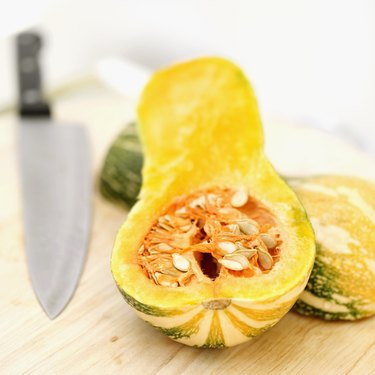
Constipation is most simply defined as infrequent bowel movements or difficulty in passing stools, which are fairly common gastrointestinal problems. According to MayoClinic.com, lifestyle changes such as exercising more, drinking more fluids and eating high-fiber foods can help prevent and alleviate constipation. Eating squash and other high-fiber vegetables and fruits is a simple, natural way to resolve constipation.
Benefits of High Fiber
Video of the Day
As the American Academy of Family Physicians points out, a high-fiber diet offers many health benefits. Dietary fiber often lowers cholesterol while also reducing risk of coronary heart disease, type 2 diabetes and various cancers. Fruits, vegetables and other high-fiber foods can naturally prevent and treat constipation as well as hemorrhoids, irritable bowel syndrome and diverticulitis, which is inflammation of pouches along the digestive tract. Eating fiber-rich foods improves digestion and nutrient absorption, and also helps you to feel fuller longer, which helps curb overeating.
Video of the Day
Squash & Fiber
According to MayoClinic.com, consume a diet with at least 20 to 35 grams of fiber every day to help your body form soft, bulky stools and prevent constipation. Squash -- both summer squash and winter squash -- is reasonably high in fiber and also supplies healthful amounts of vitamins A and C. Summer squash such as zucchini or yellow crookneck has 2 to 3 grams of fiber per 1/2 cup serving and just seven or eight calories. A 1/2-cup serving of winter squash offers 3-1/2 grams of fiber and 40 or 50 calories. Given steady supplies of squash at groceries and farmers markets, you can rely on squash for a portion of your daily fiber year-round.
Other High-Fiber Foods
While you're vegetable shopping, fill your basket with high-fiber vegetables including artichokes, spinach, sweet potatoes, potatoes, peas, snow peas and green beans. High-fiber fruits include apples, oranges, pears, dates, figs, prunes, strawberries, raspberries and blackberries. Cooking with dried beans adds inexpensive non-meat protein to the diet along with very high fiber -- 9-1/2 grams per 1/2-cup serving for navy beans, 8.2 grams for kidney beans and 7-1/2 grams for black and pinto beans. Choose whole-grain breads and cereals too, including brown rice instead of white rice, to keep dietary fiber high.
Bulk Up Slowly
Drink more water and other fluids when you start to increase the amount of fiber you eat. Liquids help your body digest and use fiber, and help soften stool. Also, gradually add bulk to your diet to avoid bloating, cramping and gas pains. Add one new form of fiber, or 3 to 5 additional grams, at a time to start increasing the amount of fiber in your diet, and wait at least a week before increasing your fiber again. Exercise regularly while adjusting your fiber intake because physical activity stimulates the digestive tract.
Is this an emergency? If you are experiencing serious medical symptoms, please see the National Library of Medicine’s list of signs you need emergency medical attention or call 911.